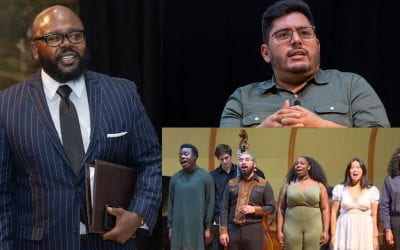Champions for Democracy
American Dream Reconsidered ConferenceHistorians Martha Jones and Lisa Materson took an incisive look at Black women’s battle for political rights, a fight that extends a century before and after the passage of the 19th Amendment.
“This history we tell has a life in the 21st century,” said Martha Jones, the Society of Black Alumni Presidential Professor and Professor of History at The Johns Hopkins University. “I hope it will help us all this more astutely, more critically and more insightfully about the contest that is upon us this fall.”
Sandra Frink, a professor in the Roosevelt University history program, moderated the conversation between the two authors at the 2020 American Dream Reconsidered Conference. After the panel, the Women’s Leadership Council hosted breakout sessions where participants could tackle ideas from the discussion in small groups.
In Vanguard: How Black Women Broke Barriers, Won the Vote, and Fought for Rights for All, Jones looks at 200 years of Black women’s political thought and activism. The book disrupts the familiar timeline that begins in 1848 with the white suffragists at the Seneca Falls Convention and stops abruptly with the passage of the 19th Amendment.
“For African American women, 1920 marks not the end of a movement for voting rights, but the beginning.”
– Professor Martha S. Jones

Lisa G. Materson is an associate professor of history at the University of California at Davis and the author of For the Freedom of Her Race: Black Women and Electoral Politics in Illinois, 1877-1932 (UNC 2009). Her book explores an era when, despite widespread disenfranchisement, lynching and Jim Crow laws, some Black women were able to cast a ballot.
Materson explained that these activists “saw themselves as proxy voters,” voting on behalf of their communities in Chicago and those who remained “under the regime of Southern white supremacy.”
Materson recounted the challenges of research in archives that centered white Americans. To reconstruct the lives of figures like major canvasser Jennie Lawrence, Materson had to sift through the letters and papers of white politicians and uncover stories in canvassing reports.
Frink asked the two historians to reflect on a few of the women who shaped the battle for voting rights without earning household recognition. Jones told the story of Hallie Quinn Brown, who migrated to Canada before the Civil War “out of a kind of despair” that slavery would never end in the United States. During the Reconstruction era, she came back to the United States, earned a college degree and became an educator. In the National Association of Colored Women, she headed the suffrage department and forged connections with civil rights activists.
“Among the women I write about in Vanguard, I hope you see the images of hundreds and thousands of other activists,” said Jones.
Viewers asked in the chat about combating voter suppression today, and how it seems like we’re “going backwards” when it comes to the right to vote.
Materson noted that, despite their formidable work and persistence, the figures she describes in her book “didn’t get many of the things that they wanted.” But their work did not stop, she said, and many of the rights they fought for are now a reality.
“The women I write about understand that politics is a long game. It is never done, and it’s certainly never done in one election cycle.”
– Professor Martha S. Jones
The American Dream Reconsidered is a free conference that invites scholars, activists and leaders to explore the modern American dream. Sessions delve into immigration, health care, politics and more in America today. With optimism and hope, our panelists share visions for the future of our democracy.
More in this section
Standing up for what is right
The Untermyer Award honors Long’s many proclivities: nominees are professors who are prolific in their subject area, are innovative in the classroom and combine their teaching with activism.
Our Ted Talk: Remembering President Emeritus Theodore Gross
Ted Gross was a great leader. A man with transforming ideas, which he enthusiastically shared. He had great expectations for us. Above all, his legacy was defined by hope.
The City and The American Dream
Cities have served as key sites of economic innovation and growth, cultural self-expression, and central American ideas, such as the melting pot. This makes the city an ideal lens through which to think about the American dream, especially at Roosevelt University in the heart of Chicago.



